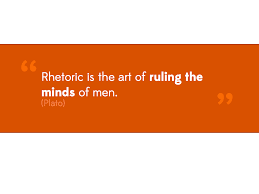Housekeeping
Return Quizzes-check math/answers
Reminder: CANVAS
Missing Contracts (6)
Akela
Nejasmyn
J'shon
Cashmir
Taylor M.
Ian
Assignment
· Read Ch. 5 in CWH (Writing Paragraphs)
· Read Ch.3 in WOW (Writing Process)
|
Introduction to Rhetoric
Discuss Mandela’s speech (page 28 in WOW)
|
|

WOW Chapter 2
Rhetoric is tool for getting what you
want
Page 21:
Rhetoric: using language effectively, no matter what purpose
the way you use language to entertain, inform, or persuade
- Aristotle "defined rhetoric as the art of finding the best available means of persuasion in any situation."
In order for rhetoric to be successful, it must include three related elements.
Audience: pg. 23 Know thy audience.
For your writing in this class, who is your audience? How will you best communicate to this audience?
Purpose: pg. 24 Understand thy purpose (purpose-what you hope to accomplish by putting something in writing)
In English 1180, your purpose is initially shaped by the nature of the assignment. Then you will further develop your purpose when you plug your chosen topics into the prescribed assignments.
The book identifies 3 general writing purposes:
- To express
- to inform
- to persuade
You'll be doing a bit of all of these in each essay that you write.
Understanding Genre
Writing purposes are also determined by the genre of the assignment
Genre: pgs. 24-25 A specific format for writing often determined by audience and purpose
Exigence: A situation or circumstance that makes you want to communicate something to someone.
-something that requires immediate action
So, how do we successfully use rhetoric?
How do we persuade our audience?
What are the tools?
These artistic appeals are the backbone of rhetoric:

Rhetoric often takes place through the use of one more of the artistic appeals:
1. pathos (persuasion that manipulates or exploits an audience's emotions or affective capacities)
2. ethos (persuasion based on the character, expertise, or ethics of the speaker)
3. logos (persuasion based on "logical" reasoning and often quantifiable grounds and evidence)
Examples of communication acts that rely heavily on pathos? ethos? logos?
Thinking about genre/audience and what artistic appeals to highlight.
dependent on purpose
Examples:
Dodge Challenger
https://www.youtube.com/watch?v=BqpJvey-7-s
Old Spice:
Bruce Campbell "Old Spice" commercial - Hungry Like The Wolf
http://www.youtube.com/watch?v=Yg6bZSM48vU
Progresso:
https://www.youtube.com/watch?v=PplMjgh_QlM&index=1&list=PLB759AD429C749932
How do we appeal to logos without including research in our writing?
pages 88-90 in Handbook
Inductive Reasoning-moving from specific facts, observations, or experiences to a general conclusion
Making Inferences-making valid statements about the unknown based on what is known or generally accepted
Deductive Reasoning-moves from generalization believed to be true or self-evident to a more specific conclusion
Page 89: syllogism example
How do these strategies tie in with audience awareness? Know thy audience.
Rhetorical Situation (WOW page 32)
-an appreciation of the social circumstances that call rhetorical events into being and that orchestrate the course of those events
-each act of communication is anything but self-contained
-each communication is a response to other communications and other social practices
-communications, and social practices more generally, are considered to reflect the attitudes and values of the communities that sustain them
Generally speaking, the rhetorical situation can be understood as the circumstances under which the rhetor writes or speaks, including:
- The nature and disposition of the audience,
- The exigence that impels the writer to enter the conversation,
- The writer’s goal or purpose,
- Whatever else has already been said on the subject, and
- The general state of the world outside the more specific context of the issue at hand.
All of these elements work together to determine what kinds of arguments will be effective (or, in Aristotle’s term, to define “ the available means of persuasion”) in the given case.

Rhetoric in Mandela's Speech (pg. 28)
Exploring how Mandela uses the artistic tools in order to persuade his audience
Group Work:
Identify a specific textual example (or two) to support your answer and be able to example how it serves as a fitting example
1. How does Mandela appeal to pathos?
2. ethos?
3. logos?
4. How does he show that he understands his audience and the delicacy of the situation?
5. Describe the rhetorical situation/the cultural climate.
Comments (0)
You don't have permission to comment on this page.